
|   |

|   |
Keremane Shambhu Hegde Rashtriya Natyotsava 6 - Sudha Sridhar e-mail: sudhasridhar@hotmail.com March 12, 2015 The sixth edition of the annual Keremane Shambhu Hegde Rashtriya Natyotsava (KSHRN), organized by the Idagunji Mela, Keremane, Karnataka had many firsts to its credit. This edition saw probably for the first time all the three streams of Yakshagana, namely the Karnataka Yakshagana (Badagutittu and Tenkutittu), Kuchipudi Yakshaganam and Melattur Bhagavathamela come together and perform in the same festival and also being part of a unique seminar on the traditions of all the three Yakshaganas by the artistes from the respective communities. The five day festival (6th to 10th February, 2015) with SNA, Ministry of Culture, New Delhi and Department of Kannada and Culture, Bengaluru as main sponsors was both lively and exhilarating in its content and presentation keeping the audience enthralled right through all the sessions. February 6 The inaugural session though being a Friday evening saw the amphitheatre with full audience while the director of the Idagunji Mela, Shivananda Hegde explained in detail as to how the sixth edition is dedicated to late Kathak Guru Dr. Maya Rao as a mark of respect and gratitude for her contribution to the art world in general and to the Idagunji Mela in particular. The inaugural session also saw the presentation of the ‘Keremane Shivarama Hegde Award’ to Nageswara Rao (Hyderabad) of Sri Venkateswara Natya Mandali, affectionately known as ‘Surabhi Babji.’ Babji is no stranger to Gunavante; his back to back performances in the fifth edition of the KSHRN 2014 was very well received. Surabhi is a unique troupe having a history of over 125 years while Sri Venkateswara Natya Mandali is a registered organization since 1937. A very deserving artist and its group to be conferred with the award for upholding the community based dance theatre tradition alive against all odds by a single family under the stewardship of Babji. The session saw a book release on the life of Late Keremane Gajanana Hegde titled ‘Yelladu bandaru Menaka’ authored by M.A. Hegde and Shivananda Hegde. The festival also saw unveiling of his statue on the last day of the festival as a mark of honour for his talent and his penchant for performing female roles metaphorically called as “Menaka who had descended upon on earth.” 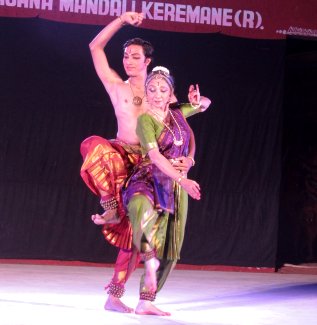 Leela Samson & Sai Santosh The cultural program of the festival was kick started by a wonderful Bharatanatyam performance by Leela Samson and Spanda Dance Company, Chennai. The group started with a Swathi Tirunal composition “Shankara Srigiri” in Mohana and Hamsadhwani raga set to adi tala, which was followed by a Muthuswamy Dikshithar composition “Ganga mampahi” in Jhinjoti raga set to kanda and eka tala. Both the compositions were very brisk, captivating and precise. The coordination, geometrical postures were in sync with the music. The group went on to perform a Purandara Dasa composition set to music by Rajakumar Bharathi with three ragas - Charukesi, Hamsadhwani and Bhimpalas set to ekta tala. The javali “Ye ra” by Dharmapuri Subarayar in Khamas raga and set to adi tala saw Leela Samson on centre stage essaying with poise and ease. The last item, a trademark tillana medley of Lalgudi G Jayaraman was in ragamalika and talamalika. The choreography skills of Leela Samson came clearly to the fore, encompassing theatre aspects, dramatization and a touch of contemporary style in presenting the items, without compromising on presenting the dance in its best pure form. 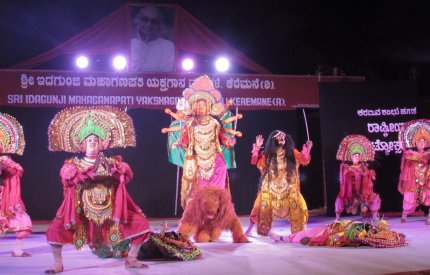 Purulia Chhau The concluding cultural program of the first day saw Purulia Chhau performance by Dileep Mahato’s troupe, West Bengal. They started with a Ganapathi pradhana and continued with Shumbha Nishumbha where the goddess Durgadevi kills the demons to save the earthlings. This was followed by the depiction of the episodes from the Ramayana - Sita Swayamvaram - and Mahabharata - Abhimanyu’s Chakra vyuham. The very colorful attire, props and the all important masks marked the different characters, who performed somersaults, turns, with remarkable dexterity and formation with only music accompaniment of shenai and drum and no dialogues or lyrics. The dramatization with only angika and aharya abhinaya for story narration with lot of emotions showed how challenging and profound is the Purulia Chhau when it comes to effectively communicate with the audience. February 7 The morning session commenced on the second day with a seminar ‘Apoorva Poorvasmarane,’ a session where different speakers paid homage to the departed artists during the year 2014 - Dr. Maya Rao, Dr. U R Ananthamurti, Mudkani Narayan Hegde and Haradi Ram Ganiga. This was followed by a Koodiyattam performance by Kalamandalam Sangeet Chakyar, Kerala. The enacting of the story with fervent drum beats and emoting of the artist in a very measured way made an interesting study for the participants who were mostly exposed to the art form for the first time. It was good to see the youngsters stay tuned to the performance till the end with rapt attention. 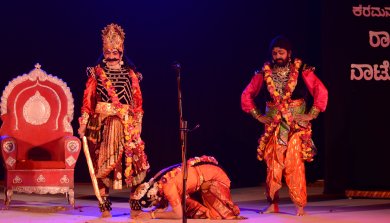 Shri Krishna Jananam and Kamsa Vadham
The evening saw the customary session wherein the Idagunji Mela felicitates artists, art patrons, journalists, organizers, etc., as a means to acknowledge their efforts in promoting art, a very well thought of initiative to keep the stream of art flow to the discerning audience throughout the state of Karnataka by encouraging the contributors to the art world in general. These sessions also kept the audience warmed up to receive the cultural program of the evening with eagerness. The second evening’s cultural events saw in the beginning a Bharatanatyam and Kuchipudi performance by Anuradha Vikrant, Shama Krishna and Divya Ravi of Ananya Institute, Bengaluru. Next was the much awaited natakam by the Melattur Bhagavathamelam - ‘Shri Krishna Jananam and Kamsa Vadham.’ The Melattur natakam being featured for the first time at Idagunji was led by S. Natarajan and his brother S. Kumar. The natakam with lively music and details of events leading to the birth of Shri Krishna, his growing years up to the killing of Kamsa performed with lot of verve and sincerity by all the members of the illustrious Mela from Tamilnadu went on well up to midnight. The importance of a script, rendering with a full fledged team of accompanists, props, rich costumes did speak a lot about the seriousness and bhakthi with which the Melattur Bhagavathamelam go about their natakams, akin to an offering to the almighty. February 8 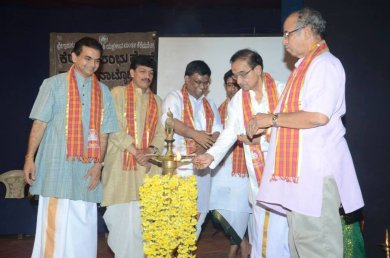 Seminar on Yakshaganams 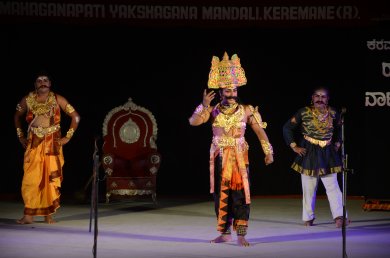 Bhakta Prahlada The seminar session in the morning featured probably for the first time primary artists from all three streams of Yakshagana talk about the traditions of Karnataka Yakshagana, Kuchipudi Yakshaganam and Melattur Bhagavathamela. S. Natarajan of Melattur shared a video of ‘Prahalada Natakam’ which is performed only at the precincts of the temple at Melattur, that too during the annual festival of the temple. He also explained how the natakam is structured and enacted by the Mela for the past couple of centuries in the recorded history of the Mela. Tadepalli Satyanarayana Sarma of Kuchipudi Bhagavathamelam spoke eloquently about Kuchipudi Yakshaganam and demonstrated with the assistance of one of the present Kuchipudi Yakshaganam’s stalwart, Vedantam Venkatanagachalapathi Rao to the music of D.S.V. Sastry, an exponent of Kuchipudi Yakshaganam sangeetha sampradayam. The participants of the seminar were more enlightened about Yakshaganam at the end of this presentation. R. Sridhar of Panchamavedam Foundation, Bengaluru, implored the three streams of Yakshaganam to come together to take proactive steps to preserve, promote and propagate the Yakshaganam tradition by having the same listed as an Intangible Cultural Heritage (ICH) of our country under UNESCO. In the transitional stage of any community based ICH like Yakshagana, the need is for ensuring documentation, various socio and economic welfare measures for the sustainability and economic viability of the art and artists, cultural and heritage tourism for propagation and promotion. This initiative which requires the active participation of all the stake holders were brought out lucidly in the informative presentation, though a lot needs to be done in this regard. Dr. M. Prabhakar Joshi, a Yakshagana scholar and writer from Mangalore, spoke about the current situation of Karnataka Yakshagana, and also welcomed the proposal for ICH jointly by the three Yakshagana streams. After the teaser of the evening’s Kuchipudi Yakshaganam ‘Bhakta Prahlada’ shown in the demonstration of the morning seminar on ‘Traditions of Yakshaganam,’ the high level of expectation from the audience for a wholesome entertaining evening was very much evident. They were not disappointed as the performance of the youngsters of the Kuchipudi Bhagavathamelam which has a recorded history dating back to several centuries was really exhilarating. The very well known Narasimha avatar was dealt with lot of dramatic, poignant, gripping narration and above all the melodious spirited singing by D.S.V. Sastry did assist the group ably led by Vedanatam Venkatanagachalapathy Rao who essayed the role of King Hiranyakasipu to a nicety which was thoroughly enjoyed by both the elders and youngsters in the audience. 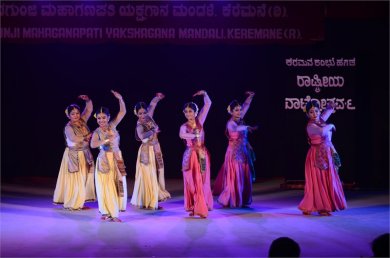 Sattriya performance 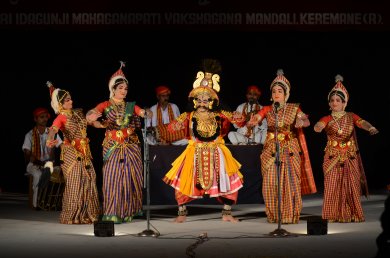 Karthaveeryarjuna Kalaga This was followed by a Sattriya dance recital by Sattriya Kendra of SNA, Guwahati, Assam. The Sattriya dance evolved from the Ankiya nat Bhaona, the Vaishnava theatre introduced by saint Srimanta Sankaradeva with both vigorous and graceful component of dance was later pursued and practiced as part of various prayer services in the Sattra institutions. The first item was Krishna Vandana with Sutradhari dance in Suhai and Dhanasri raag set to ek and rakta taal. This was followed with a Jhumura dance, abhinaya in Bargeet and Chali dance, a lasya section of the Sattriya tradition. The theme of bringing together all the three streams of Yakshaganam for the benefit of the audience to appreciate their similarities as well as uniqueness was complete with the presentation of Karnataka Yakshagana (Badagu tittu) ‘Karthaveeryarjuna Kalaga’ by Sri Idagunji Mahaganapati Yakshagana Mandali, Keremane, featuring Chittani Ramachandra Hegde and Shivananda Hegde. It was watched by the Sunday evening crowd with delight, savouring each and every moment of the Yakshagana which went beyond midnight as is wont when it comes to Yakshagana plays. February 9 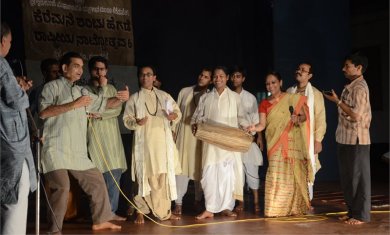 Seminar on Sattriya 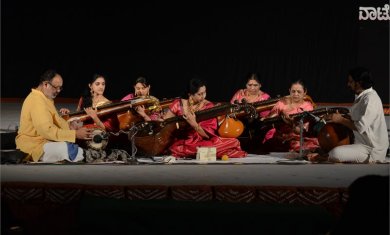 Suma Sudhindra and group 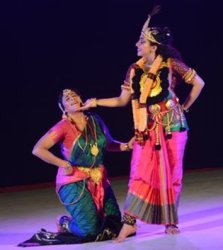 Vyjayanthi Kashi & Prateeksha Kashi The evening’s cultural event saw for the first time during the festival, music recitals. Dr. Suma Sudhindra, Bengaluru and her group’s veena recital was followed by Kabir Gayan by Shri Prahlada Tiphaniya, Bhopal. Dr. Suma Sudhindra’s recital featured a couple of Saint Thyagaraja’s compositions, namely Samaja Vara Gamana in Hindolam ragam set to adi tala and Manav Alakinchara in Nalinakanta ragam set to adi tala which were outstanding. The Natyotsava saw the Kuchipudi performance of Vyjayanthi Kashi and Prateeksha Kashi of Bengaluru and also a Sattriya dance drama ‘Chandalika’ by Sattriya Kendra of Sangeet Natak Akademi, Guwahati, Assam. February 10 During the evening session of the final day of the festival, B.S. Yediyurappa, MP and Former Chief Minister of Karnataka, presided and unveiled the statue of Keremane Gajanana Hegde at the venue ‘Yakshangana.’ The Dhrupad sangeet recital by the Gundecha brothers, Umakant Gundecha and Ramakant Gundecha of Bhopal, Madhya Pradesh, started the evening cultural performance of the final day. This was followed by an excellent Kathak performance by Nirupama and Rajendra of the Abhinava Dance Company, Bengaluru. The final performance of the festival was a very colorful Karnataka Yakshagana (Tenku tittu) ‘Raja Soudhasa’ by Shri Sharat Kadri Troupe, Mangalore. The evening sessions were webcast live and the organizers had thoughtfully also arranged for a photo display of the three streams of Yakshagana for better appreciation of the art form by the audience. 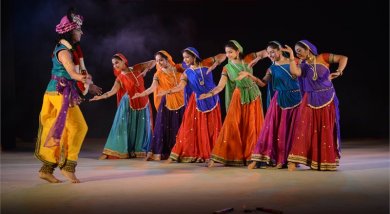 Nirupama and Rajendra with group  Raja Soudhasa The sixth edition amidst the natural settings, cool evening breeze, pleasant night chillness and the enchanting fragrance of Night Queen flower made it seem like the performers on the well lit amphitheatre stage were celestial dancers and musicians who had descended from heaven to perform, entertain and educate at the Gunavante village, the abode of the Keremanes who are to be appreciated and thanked profusely for putting together a wonderful, unforgettable festival. Sudha Sridhar, a double graduate in Law & Dance is a cultural activist working on advocacy efforts to preserve, promote and propagate art forms and for the cultural rights and welfare measures for artists. Currently her main focus is on Kuchipudi heritage village and promotion of all the three streams of South Indian Yakshagana - Karnataka Yakshagana, Kuchipudi Yakshaganam and Melattur Bhagavathamela. |